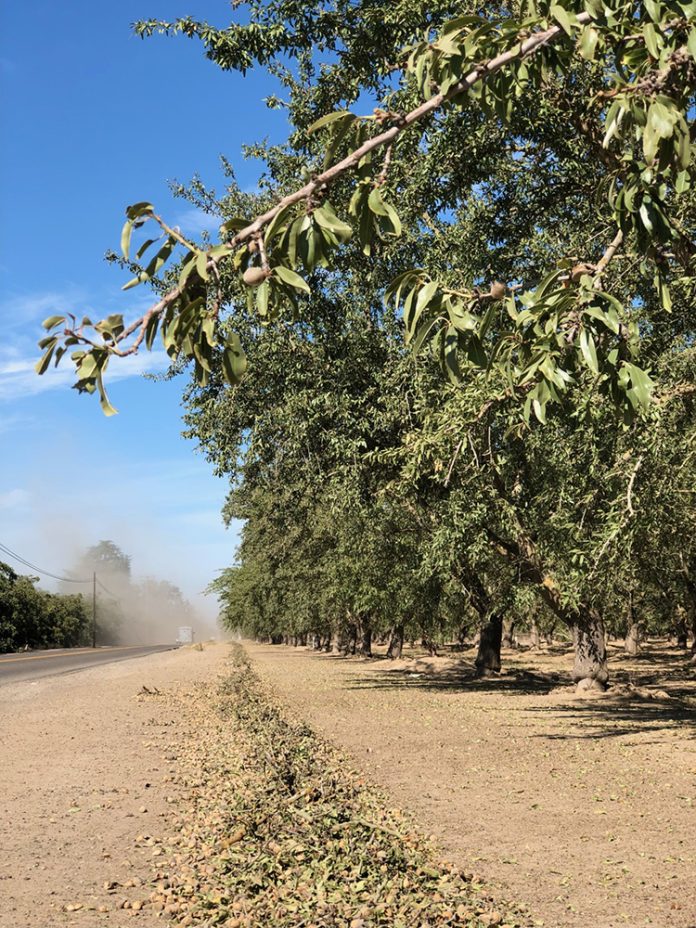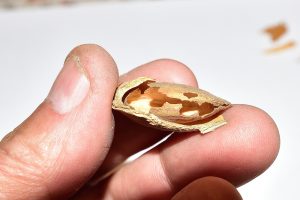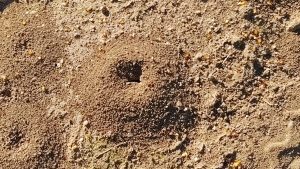
Almond growers are familiar with the hungry, protein-loving ants that quietly eat their fill of nuts as they sit on the ground after shaking. While IPM plans typically include monitoring for ants in the spring months, as growers roll into the summer and start looking toward harvest season, ants should still be on their radar.
There are two kinds of ants of concern to growers in the Central Valley: the more northernly pavement ant, a 3/16-inch dark brown to black colored ant, and the southern fire ant, 1/4 to 1/3 inches long and whitish gray in color. The latter is believed to cause the most damage, according to Jhalendra Rijal, a UCCE IPM advisor for Stanislaus County.
There’s an easy and cheap method to determine if you’ve got one of these types of ants. Placing a piece of hot dog inside a plastic bag and laying it on the ground in an orchard will attract a protein feeding ant in a matter of hours.
“If they are protein feeders, they will go after it,” Rijal said.
The tried-and-true method can be used during different times of the year to look at activity early in the season and even as a tool to evaluate if baits and insecticides are effective or not later in the season.

Spring Through Harvest
Ants begin their activity in the springtime as temperatures warm up but won’t usually be active early if the climate is still cool and wet. Speculating on whether the long, wet winter made a difference in ant activity, Rijal said it’s possible it might delay it slightly, but is still yet to be determined and no reason to drop your guard.
“Even though their activity might be a little slower earlier, when the temps start hitting red, then it really doesn’t matter; they will come back to the more or less similar level of activity and can do substantial damage,” he said.
While IPM plans should help substantially in the control of ants, Rijal said it’s easy for a problem to be created if you aren’t paying close enough attention. He encourages growers to continue to monitor for active mounds in the orchard based on the UC IPM data collection template, which estimates about 15 colonies in a 5,000-square-foot area.
“If you were able to harvest within seven days after shaking, then you’re expecting about 1.6% damage, but if you harvest 10 days, instead of seven days, you’re looking at 30% more damage,” Rijal said.
Blue Diamond Member Relations Vice President Mel Machado said recent observations in his own Oakdale, Calif. orchard tells him the wet weather really didn’t make any difference to solve or reduce the ant problem this year.
“Those little buggers are tough,” Machado said. “Looking at my field, they survived quite nicely. I would not count on people saying the rain drowned all the ants.”
As the summer lends its way to weeds, Machado said you might have ants and not even realize it if you’re only looking for their mounds.

“The message for growers is, sometimes you don’t see the ant hills,” he said. “If you’ve got weeds that they like, particularly weeds with high-oil seeds, purslane, spurge, pigweed, look underneath. You’re more than likely going to find them.”
According to records kept by Blue Diamond for growers who have requested tracking, between 2011 and 2022, protein feeding ants caused 18.9% of total reject damage in Nonpareil, with the range from 15.9% to 26.8%. In Independence, ants represented 22.5% of total rejects, ranging from 19.0% to 37.3%.
The data also showed the percentage attributed to ants is much lower on varieties with better shell seal, generally in the high single digit levels. Some almond varieties, like Padre, can withstand damage from ants naturally due to a tighter shell seal, but all it takes is enough open space for an ants head to fit inside for it to become ant food, Machado said.
“If there is any opening at all in that shell, they’ll get in there,” he said. “I have seen ants tear up the Butte because it can have an opening along the wing of the shell. They don’t touch the Padre because they can’t get in the Padre shell.”
Best practices going into the summer months can include a number of baits, according to Rijal, who said several are working well for growers right now, including Abamectin Clinch, Altrevin and Metaflumizone, each of which has its own window for when it should be used, anywhere from 4 to 10 weeks before harvest. He cautions, though, that several things can affect bait, including a wet orchard, length of time the bait has been stored and even a weedy orchard that makes bait less attractive to ants.
Drying Length Depends on Timing
While growers know it’s important to get nuts off the ground as soon as they’ve had enough time to dry out, Machado says getting to know your orchard long before harvest to catch the ideal shaking window might be just as importan as an IPM plan for keeping the ants out of your harvest.
He noted one of UC’s recommendations throughout the years has been for early harvest but clarified ‘early’ isn’t really the right word.
“I personally rip the word ‘early’ out of every presentation I see and I replace it with ‘timely harvest,’” Machado said.
Growers who harvest too early end up with a product that is too green, he explained, adding several things can affect the ideal window for shaking, including having to contend with a bloom that’s very long in some varieties and very short in others.
“You’ll have nuts, literally, on the same spur or the next spur, that are two weeks different in age and maturity,” Machado said.
He explained nuts that have been on the ground long enough should have a target of 5% kernel moisture, while anything above 6% generally can’t be stored.
Although he said he understands early harvest for Nonpareil management, Machado said pushing for harvest too early will lead to a product that has to stay on the ground longer, adding to the danger of ant destruction.
The key, he adds, is spending real time getting to know your orchard.
“The best fertilizer you can apply is the leather of your shoes,” he said. “The thing we drive at Blue Diamond is know the basics, excel at the basics.”

Kristin Platts | Digital Content Editor and Social Correspondence
Kristin Platts is a multimedia journalist and digital content writer with a B.A. in Creative Media from California State University, Stanislaus. She produces stories on California agriculture through video, podcasts, and digital articles, and provides in-depth reporting on tree nuts, pest management, and crop production for West Coast Nut magazine. Based in Modesto, California, Kristin is passionate about sharing field-driven insights and connecting growers with trusted information.















